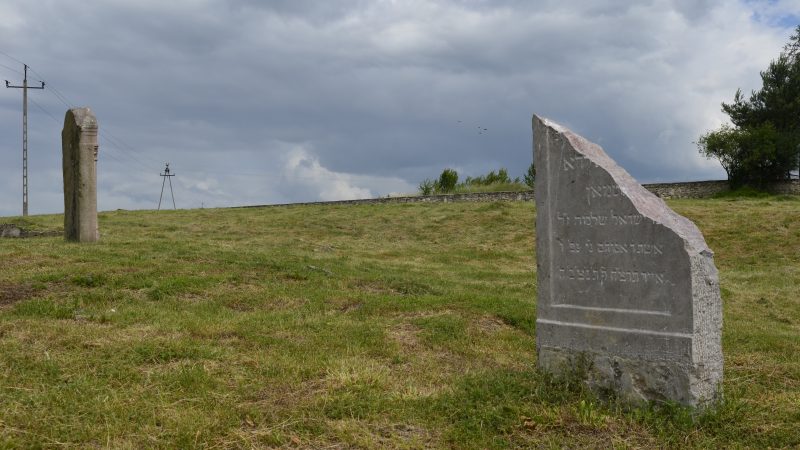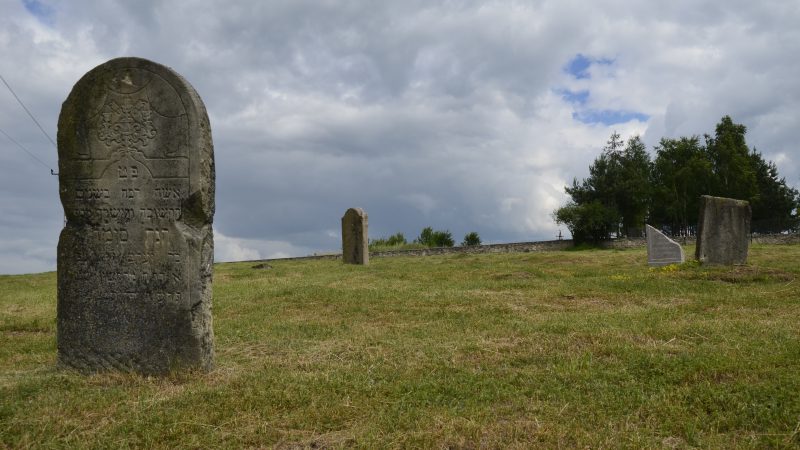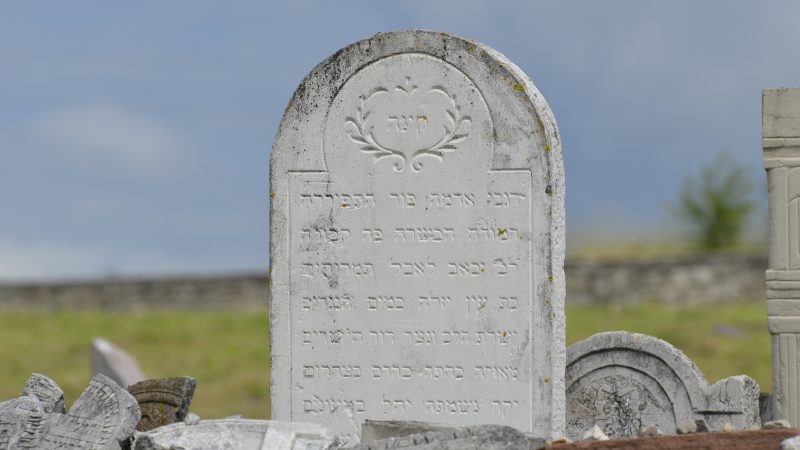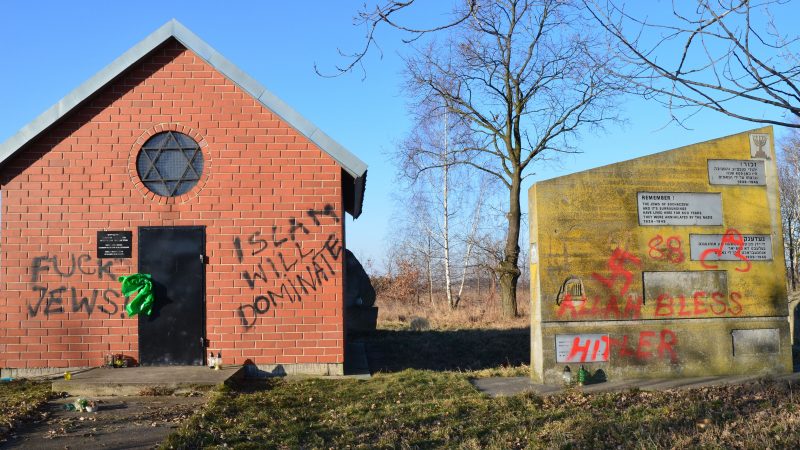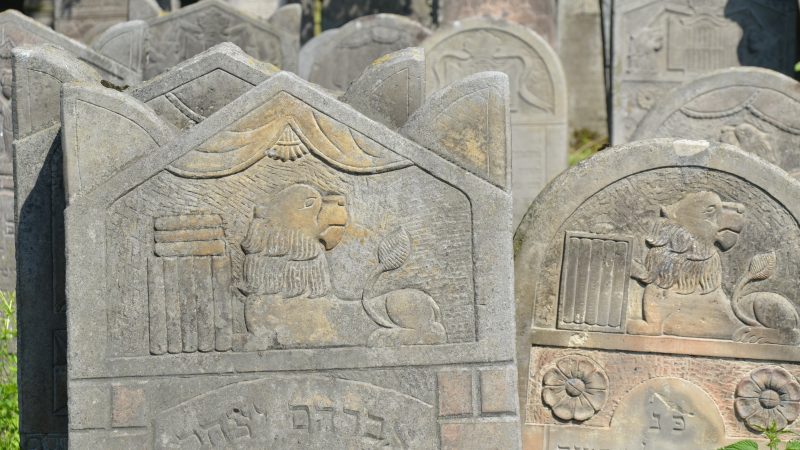Jewish cemeteries in Poland have remained in the long shadow of the Holocaust
About the destruction of Jewish cemeteries during World War II, after the years of 1945 and 1989, what they mean to contemporary Poles and why the process of their destruction – initiated by the Germans – continues to this day, we are talking to the researcher of Jewish cemeteries and the publicist, Krzysztof Bielawski, the author of the book “Zagłada cmentarzy żydowskich” (“The Holocaust of Jewish cemeteries”), published by “Więź“
14 September 2020
You are the author of the recently published monograph about the destruction of Jewish cemeteries in Poland. How did the Holocaust affect this process?
There were various ways in which the devastation of the cemeteries took place from the onset of the Jewish settlement, but their destruction on an unprecedented scale began just after the outbreak of World War II. Germans destroyed hundreds of cemeteries in the conquered areas, using tombstones as the reinforcement material for roads, sidewalks and yards as well as for many other construction purposes. Some cemetery grounds were developed. Some of the cemeteries were devastated during military operations – there were fights taking place on their sites, and the fortifications were built on them.The situation was different in the territories which until 1939 were incorporated in the Third Reich and which after the war were annexed to Poland. There were attempts made by the German administration to sell tombstones, cemetery grounds and buildings, however, those transactions were hindered by complicated procedures and legal problems. This may come as a surprise that the regulations that prohibited the digging through the graves for 40 to 50 years since the last burial were generally complied with. As a consequence, many cemeteries located in the “Recovered Territories” survived the war in a relatively good condition. However, there is no doubt that if the Nazi totalitarian system had been established, the cemeteries of German Jews would be further devastated.At the same time, as a result of killing about 90 percent of Jewish population in Poland, Germans deprived the cemeteries of their natural guardians for the next decades. By paraphrasing the title of the book by professor Feliks Tych, it can be said that Jewish cemeteries in Poland have remained in the long shadow of the Holocaust.Sadly, already during the war, some local inhabitants started to destroy the cemeteries. In the book, I quote numerous such cases based on the materials by Adam Czerniakow, Emanuel Ringelblum and the accounts of other witnesses. This process intensified after the establishment of ghettos and was further exacerbated after the extermination of the Jewish population in 1942-1943.
What is the destruction scale of Jewish cemeteries by the local Polish population?
This cannot be expressed in a measurable way, for example as a percentage, but it is certainly a large proportion. No less than tens of thousands Poles participated in that procedure – it is enough to be said that an average of 30 people contributed to the devastation and the desecration of almost each of the 1200 cemeteries throughout approx. 70 years. Historical archives, various reports and photographs show that those cemeteries were gradually disappearing. The town of Błonie near Warsaw is an example. The collection of the Emanuel Ringelblum Jewish Historical Institute includes a photo taken in the 1960s, showing at least several dozen matzevots standing in compact rows. At the beginning of this century, there were only standing tombstones and about 30 fragments. At that time, some single-family houses started to be erected near the cemetery which for many years was located far in the fields. In 2014, an unknown perpetrator smashed the last matzevots, and their destructs were taken by the police. If it wasn’t for the gate pillars and the fence erected in 2016, the cemetery would have completely disappeared from the landscape. In the book, among other things, I mention the history of the cemetery in Szydlow, where, according to the official report, there were over eleven hundred tombstones in 1946. They are also shown in the photographs from the 1950s and the 1960s. Today, there are no traces of the cemetery on the ground. Unfortunately, such situations were taking place all over Poland.
How big was the role of the current policy of the Polish People’s Republic in bringing about the destruction of cemeteries that survived World War II?
The post-war Polish state, understood as the authorities and state enterprises, was the main perpetrator of further destruction of cemeteries, besides the local population. That stemmed from the introduction and application of the regulations which limited the development of Jewish organisations and deprived them of the property rights of the prewar Jewish communities, the regulations governing the functioning of cemeteries without respecting the rules resulting from religion and tradition, and from direct active participation in the destruction of cemeteries and the failure to ensure sufficient protection of them. In 1958, the Ministry of Municipal Economy tried to implement a program to clean up the so-called “deserted cemeteries”, including Protestant and Jewish ones, however, the task was not completed. Instead of ensuring regular care, it was more profitable for local national council presidencies to liquidate the cemetery and allocate it for another purpose. As a result, hundreds of cemeteries were built up, transformed into parks, playgrounds, fields and farmlands. Some cemeteries were taken into private use.By the way, I would like to draw attention to one fact. You can often find information about the total destruction of cemeteries by Germans during the war. They contain two fundamental errors. First of them is the claim of “total destruction of a cemetery”. Such action would involve the removal of all above-ground elements of the cemetery as well as the full exhumation of the dead, including their ashes. However, there were no such cases. Even on two cemeteries in Podgórze in Krakow where the Germans established the camp in Plaszow, the remnants of tombstones have remained up to this day, and the bones were dug out during the earthworks in 2016. The second mistake is attributing the destruction of the cemeteries to the Germans only. In fact, the cemeteries that were more or less devastated by the Germans during the war, were also destroyed after the war, with the participation of local inhabitants and the authorities. At the other extreme, some cemeteries were spared from destruction by the Germans or by their order, but they were destroyed by the local residents and post-war authorities. We can also point out to the cemeteries destroyed by the Germans and the local residents or only by the local residents, but in both cases without the participation of post-war authorities.
Who are the people that have been involved in the deliberate destruction of cemeteries after 1945 and 1989?
They are both uneducated people and the representatives of the social elite, inhabitants of towns and villages. Many acts of vandalism were committed by the minors. Numerous mentions indicate the participation of peasants. Among the perpetrators, there were also educated people who held prominent positions – among others, officials, also high-ranking officials – often respected by the local community. In one of the towns near Warsaw, a teacher built a house on a local cemetery. In Brańsk, Goworowo and Sobienie-Jeziory, the destruction was somehow legitimized by Catholic priests, who for decades have been walking on sidewalks made of matzevots in front of parsons and churches. In the monastery in Kazimierz Dolny, a few years ago, I saw a stone with a Hebrew inscription, stuck in the corridor floor. These are matzevots that were brought there during the war, by the German order, however, the fact of using them for different purposes is a form of consent to such treatment of tombstones by other people. Similarly, the directors of the General Secondary School No. 3 in Inowrocław, whose courtyard was lined with hundreds of fragments of broken tombstones until 2011, could not solve the problem. After 1989, as a result of the economic system reorganisation, the role of private entrepreneurs in the process of destruction increased. To them, the cemeteries became a desirable investment land.
In what categories are the Jewish cemeteries perceived today and what do they mean to contemporary Poles?
For some Polish people, of course, they are burial sites, objects of historical value, and often also the places of martyrdom. However, I often see that they are treated with contempt. In the book, I quoted a reflection of a sociologist Sławomir Kapralski, who stated, based on field research, that for many Poles the Jewish cemeteries are not cemeteries, but “places from another order”. Such treatment of the cemeteries is, unfortunately, a manifestation of xenophobia and anti-Semitism.
Why has the process of destruction of the Jewish cemeteries, initiated by the Germans during World War II, been continued to this day?
It is mainly caused by the fact that, as a result of the murder of the majority of Polish Jews, the previous caretakers of those places are not there anymore. The process of destroying cemeteries is different today than it was in the times of the Polish People’s Republic. The participation of state and local government institutions is much smaller, even marginal, although such cases still occur. For example, in 2008-2009, the graves on the cemetery in Ostroleka were dug through during the rebuilding of the Korczak Street. In 2017, the Zamosc authorities built a road through the cemetery, and at the end of last year, there was a dispute over the cemetery in Jaslo, related to the construction of a bypass in the town. The destruction of cemeteries by individuals is also different. In the era of new technologies, the matzevot are no longer a desirable building material. The devastation on the cemeteries is mainly done by hooligans and people presenting anti-Semitic attitudes. I would like to add that in the last few days, several cases of breaking and damaging matzevots, in as many as three cities – Dobrodzień, Tarnowskie Góry and Zabrze – were revealed. The cemeteries that have become the property of private users are also beyond the supervision. They serve as sites for single-family housing, company buildings or recreational plots. Apart from the devastation caused directly by people, the cemeteries are also decaying as a result being affected by water, air pollution, temperature changes, biological factors, metal corrosion, expansion of cemetery greenery, storm, lightning, floods, fires, mining damage, presence of animals. As Jan Jagielski from the Emanuel Ringelblum Jewish Historical Institute once recorded, “those cemeteries are dying”.
Why there are relatively few Poles interested in destroying cemeteries, which, after all, are the part of the history of this country, and why only a few Polish people are outraged by the fact of their destruction?
First of all, we should remember that the Jewish cemeteries are located in about 950 towns, therefore, many Poles do not live near them. The average Kowalski has other interests; they do not deal with monument protection. Additionally, in the case of Jewish cemeteries, there is a factor of “strangeness”, which is why in the opinion of many people taking care of cemeteries is a task for unspecified Jews only. Various Jewish organisations from Poland and abroad carry out numerous cemetery renovation projects every year, however, they are not able to effectively take care of all 1200 cemeteries. The number alone shows that the task is enormous, and the task of taking effective care of the cemetery is a complex one and requires regular work. Fortunately, since 1989, more and more non-Jewish guardians has been taking care of the cemeteries. Among them are local community members (for example, Eugenius Kuteń and Marian Skwara from Pruszków, Zbigniew Romaniuk from Brańsk) and organisations (for example, the Society of Zalew Land Lovers, “Borussia” Foundation from Olsztyn, “Dukla Shtetl” Association, Society of New Żmigród Lovers). The works are motivated by the desire to take care of the graves of the former inhabitants of the town, the concern about the cultural heritage, and the interest in Jewish culture.
How many Jewish cemeteries today are the commemorated places of extermination?
I do not know the number and I assume no one can provide it. For several years, the documentation of commemoration has been created by Jan Jagielski, but that list is still not ready yet. A lot of such information can be found on the Virtual Shtetl website, but that data is not complete either. Many places like that are still not commemorated. It should be noted that the Jewish cemeteries were the sites were Germans shot the Jews captured while in hiding, apart from executions during the period of ghettos’ functioning until the end of the war. Those Jews were buried in unmarked graves, about which only a few people know today. There are also mass graves with no monuments. Two such graves are located on the cemetery in Minsk Mazowiecki. An important thing is that each year there are more and more commemorations. The monuments on the cemeteries are created by the initiative of the Jews living in Poland, the emigrants and their descendants and non-Jewish Poles. This is very positive, but there is still much to be done.
Interview conducted by: Anna Kilian
Photo Published by: Więź” and Krzysztof Bielawski


